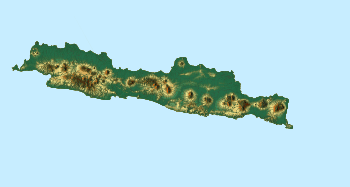Ci Manceuri
| Ci Manceuri | |
|---|---|
 Location in Java | |
| Country | Indonesia |
| Physical characteristics | |
| Main source | Java |
| River mouth | 6°02′18″S 106°27′31″E / 6.038425°S 106.458716°ECoordinates: 6°02′18″S 106°27′31″E / 6.038425°S 106.458716°E |
Ci Manceuri, or Cimanceuri[lower-alpha 1], is a river in the Banten province of western Java, Indonesia.
Location
Ci Manceuri forms at the confluence of the Ci Dangdeur and Ci Jengir and flows northwest and then north to discharge into the Java Sea near Lontar, Kemiri District in the Tangerang Regency.[1] The rivers in Banten, the westernmost province of Java, run roughly parallel to each other. The main ones are the Peteh, called the Banten on the lower reaches near the city of Kota Banten, the Ujung, which enters the sea at Pontang, the Durian, which enters the sea at Tanara, the Manceuri, and the Sadane, which rises in the mountainous region of Priyangan and in 1682 formed the border between the Dutch East India Company (VOC) territory and Batavia (modern Jakarta).[2] The Durian, Manceuri and Sadane rivers flow through the Tangerang Plain.[3] The rivers fan out into deltas near the coast. There are marshes between the mouth of the Durian at Tanara and the mouth of the Sadane.[2]
Irrigation works
The Tangerang Plain was still owned by private landlords in the early 20th century. The farmers grew low-quality rice, mostly using rainfall-based water storage and irrigation systems that depended on the whims of landlords for functioning of key components, with arbitrary water distribution. They suffered from poverty and famine or food shortages.[3]
In 1911 the colonial government started to prepare an irrigation plan, and in 1914 determined that various tracts in the plain should be subject to compulsory purchase for this purpose. The original plan was to use waters from the Ci Durian, Ci Manceuri and Ci Sadane rivers. Plans to use the Cimanceuri were dropped due to its irregular supply and poor quality water. In 1919 a plan was issued where the north of the plain would be irrigated by the Ci Sadane and the southern area by the Ci Durian.[4] In this plan the Ci Durian canal would extend to the Ci Manceuri. Later this was changed to extend the canal by an aqueduct over the Ci Manceuri.[5]
Planned extensions to the Ci Durian irrigation network were delayed in the post-colonial era, as were repairs to the existing works. The planned aqueduct over the Ci Manceuri was not completed until the 1970s.[6]
See also
Notes
- ↑ The river's name is also written as Tji Mantjeuri or Tjimantjeuri
- ↑ Jakarta, Bogor, Depok,Tangerang...
- 1 2 Talens 1999, p. 40.
- 1 2 Kop, Ravesteijn & Kop 2016, p. 298.
- ↑ Kop, Ravesteijn & Kop 2016, p. 299.
- ↑ Kop, Ravesteijn & Kop 2016, p. 310.
- ↑ Kop, Ravesteijn & Kop 2016, p. 314.
Sources
- Jakarta, Bogor, Depok,Tangerang, Bekasi, Puncak Dan Cianjur Arahan Sistem Air Baku Dan Pengendalian Banjir (in Indonesian), Badan Koordinasi Tata Ruang Nasional Penataan Ruang Kawasan, retrieved 2017-01-29
- Kop, Jan; Ravesteijn, Wim; Kop, Kasper (21 March 2016), Irrigation Revisited: An anthology of Indonesian-Dutch cooperation, Eburon Uitgeverij B.V., ISBN 978-94-6301-028-3, retrieved 27 January 2017
- Talens, Johan (1 January 1999), Een feodale samenleving in koloniaal vaarwater: staatsvorming, koloniale expansie en economische onderontwikkeling in Banten, West Java (1600–1750) (in Dutch), Uitgeverij Verloren, ISBN 90-6550-067-7, retrieved 27 January 2017